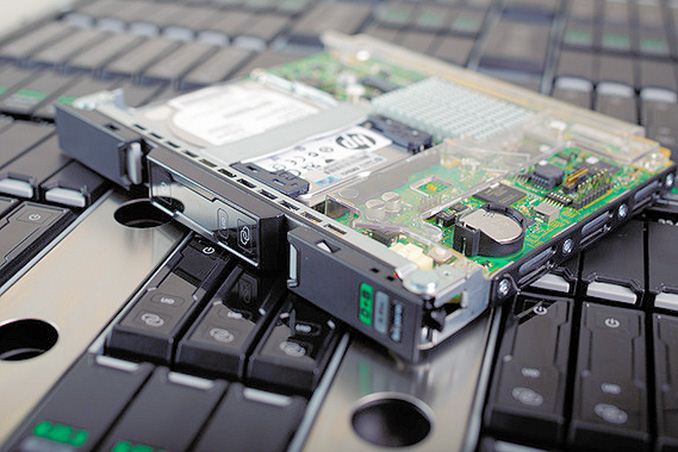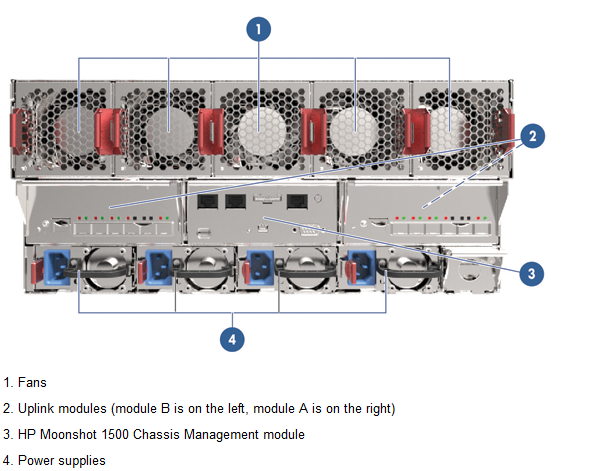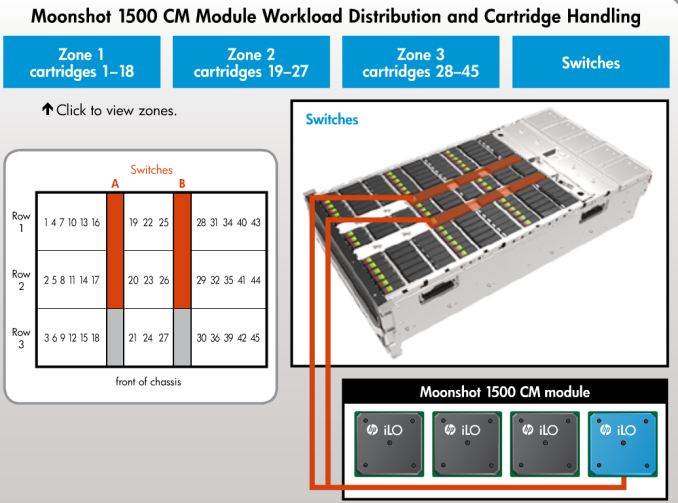Server Update April 2013: Positioning the HP Moonshot 1500
by Johan De Gelas on April 11, 2013 8:11 AM EST- Posted in
- Enterprise CPUs
- Arm
- Xeon
- Enterprise
- Calxeda
- S1200

HP is not shy of grand statements when it is describing its newest baby: "historic", "enables unprecedented scale" "revolutionary new architecture". HP claims "maximum density" and "unparalleled power efficiency". That of course, simply begs for closer inspection.
The HP Moonshot 1500 System chassis is a proprietary 4.3U chassis that is pretty heavy: 180 lbs or 81.6 Kg. The chassis hosts:
- 45 hot-pluggable Atom S1260 based server nodes
- A backplane with 3 different "fabrics": network, storage and cluster
- Two Ethernet switch modules
- Two uplink with SFPs
- a management module (with a sort of ILO "light")
- Two to four 1200W PSUs (94% efficient)
- 5 dual rotor, hot plug fans (N+1 redundancy)
Each server node has two 1 Gbit connections to one of the two Ethernet switch modules, or four Ethernet links in total. The cluster fabric allows a fast 2D Torus interconnect for linking up server nodes. The storage fabric is implemented but seems to be unused for now.
The two switch modules are located in the middle of the chassis, and are placed in the length of the backplane. They can be teamed up, but will probably end up in a redundant 1+1 configuration. The server nodes connect to the backplane by using PCI express slots, and also get their power from PCI Express pins, similar to what SeaMicro servers. All fans are located at the back of chassis.

The back is very similar to a blade chassis, with shared power, fans, management and uplink modules for all 45 server nodes.











26 Comments
View All Comments
dealcorn - Thursday, April 11, 2013 - link
It makes me wonder why HP has been hogging almost all Intel's S1200 production capacity. HP may think there is a use case where some customers will find Moonshot attractive.Is Briarwood (S12X9) the end of the road for Atom at 32 mn? The addition of many Crystal DMA engines to provide a hardware assist in RAID6 calculations lets Atom be a category killer (in a niche market). I find it funny that after all the criticism, the venerable Atom core is departing 32 nm as a (niche) category killer.
Ammohunt - Thursday, April 11, 2013 - link
The should have named this product line Crapshoot you would think they would learn from past dealings with intel. As a career Systems Administrator i don't find this to be an attractive product as compared to scaling density using 1-2U servers crammed with ram running a modern hyper visor with 24 or more cores. At the same time a 1-2U server can be re-purposed for dedicated tasks.Spunjji - Friday, April 12, 2013 - link
Pun win.Jaybus - Friday, April 12, 2013 - link
Which makes me question why a E5 2650L, a 1.8 GHz Sandy Bridge part, was used as a comparison. WIth the E5-2600 V2 series being launched soon, I think an Ivy Bridge E3 would have been a better comparison. The 10 core E5 V2 at 70 W will allow 20 Ivy Bridge cores (40 hyper-threads) at around 3 GHz and at least 256 GB of RAM in a 1U space. That will allow a lot of web server VMs from a 1U. Can these Atom and ARM systems run as many web servers in a 1U space? For some of us, that is a more important question. Performance per Watt is important, but it doesn't necessarily translate to better performance per 1U space, which is the more important metric for some of us.Wilco1 - Friday, April 12, 2013 - link
Well according to Anand's Calxeda test, you need 2.7x as many Cortex-A9 cores than E5-2660 threads to equal it on webserving. With Cortex-A15 being at least 50% faster than the A9 that reduces to 1.8x. Assuming the E5 V2 is 25% faster, it becomes 2.3x. The max density of the Moonshot is 45 x 4 quadcores in 4.3U, so about 167 cores per 1U vs 40 threads for the E5 V2, ie. it gives 1.8 times as much performance per 1U.vFunct - Thursday, April 11, 2013 - link
Can we have ARM SoC's with stacked 128GB NAND flash chips on an interconnected grid already?It's obvious that this is where everything is headed. Don't need a giant cartridge/module when everything can be done in a stacked die. Or, perhaps just add an ARM core/network interface to NAND FLASH.
You could probably fit several thousand of them in a chassis. Maybe several hundred thousand in a rack.
wetwareinterface - Friday, April 12, 2013 - link
and that would be a fire you could see from space. a stacked die? and several thousand in a chassis...would require a cooling solution based on vapor phase and massive heat exchangers to keep it from burning itself up.
and further the arm cpu with the ability to access more than 4 GB of ram doesn't yet exist. tying slower flash to it isn't a solution either except in a san. and that would be fairly pointless as you'd hit a bottleneck on the network side so flash storage would be a pointless expense.
Wilco1 - Friday, April 12, 2013 - link
The HP Moonshot server supports 7200 ARM cores already using air cooling. Given that a typical quad core node uses about 5 Watts, stacking flash and/or RAM is certainly feasible. This is pretty much what many mobile phone SoCs already do.Also ARM's with more than 4GB capability have been on the market for at least 6 months - Cortex-A15 supports 40-bit addressing.
wetwareinterface - Monday, April 15, 2013 - link
okay i'll bite...first off, and i quote, "Don't need a giant cartridge/module when everything can be done in a stacked die." everything that module contains stacked up would equal a heat dissipation nightmare.
or the second option of just adding an arm core and network interface on top of flash would net nothing but a slow waste of cash.
and also the a15 has a 40 bit address space so it can see up to 1 TB of ram but each thread can only use 32bit of that address space so.... 4GB cap.
and stacking the ram and or flash is feasible... but when you cram a bunch of modules together in the thousands you have heat dissipation problems. the tighter you group the heat sources the more geometrical progression for heat buildup becomes an issue. that heat has to go somewhere and with nowhere to go and no air volume to exchange with the more you have to go with extreme cooling solutions.
phones get away with stacking the cpu and other elements because they don't have to run more than a few minutes accessing those elements at once so heat buildup doesn't become a problem in a typical use scenario. but it does cause issues when you use a phone outside the typical usage it sees.
a server would melt down with all that being accessed at once and constantly if it were stacked and air cooled.
vFunct - Monday, April 15, 2013 - link
If only there were some way to remove that heat, in a way that would "cool" the system..Also, the ARM A15 is the last ARM core ARM will ever design. They don't plan on making any future designs past that. There are no plans on making 64-bit ARM cores, ever.
So, everything you say is right.